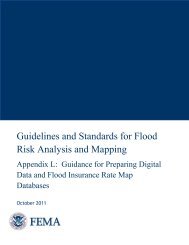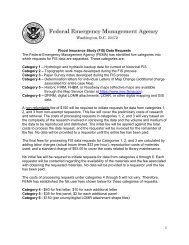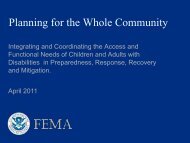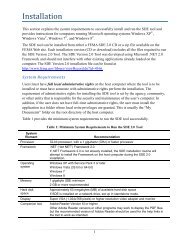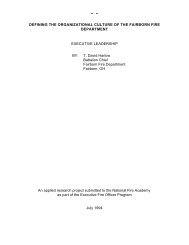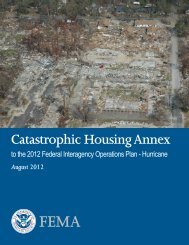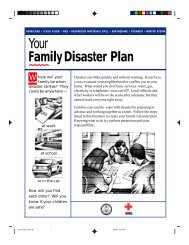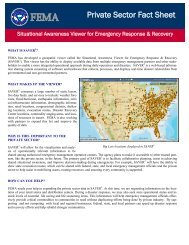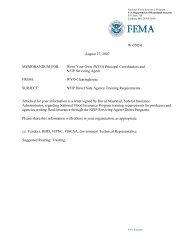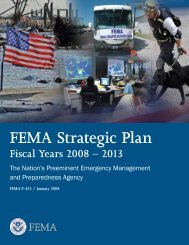Joint Field Office Activation and Operations - Federal Emergency ...
Joint Field Office Activation and Operations - Federal Emergency ...
Joint Field Office Activation and Operations - Federal Emergency ...
You also want an ePaper? Increase the reach of your titles
YUMPU automatically turns print PDFs into web optimized ePapers that Google loves.
UNCLASSIFIEDpriorities: it is also a substantive analysis (<strong>and</strong> correction) of gaps, seams, <strong>and</strong>overlaps in objectives <strong>and</strong> priorities to produce the best <strong>and</strong> most agile <strong>and</strong> effectivenational response possible.• Continuity of <strong>Operations</strong>, Transition of Responsibilities, <strong>and</strong> “Exit Strategy.”The safety, security, continuity of operations, <strong>and</strong> (eventual) transition ofresponsibilities <strong>and</strong> demobilization of the JFO should be an immediate concern ofthe JFO Coordination Group. During massive response operations, such prioritieswill often appear to be secondary, but excessive delay in tasking the Section Chiefswith specific objectives in these areas may place the continuity of the nationalresponse in jeopardy <strong>and</strong>/or unnecessarily tax national resources with inefficientoperations.• Interagency Information Management. Nongovernmental, private-sector, <strong>and</strong>regional <strong>and</strong> international organizations may possess considerable information thatmay be essential to the success of the coordination <strong>and</strong> support operation. Reliefworkers have a comprehensive underst<strong>and</strong>ing of the needs of the population <strong>and</strong>can offer effective assistance to disabled, non-English speaking, <strong>and</strong> “specialneeds” individuals. Working closely with local communities, they underst<strong>and</strong> localculture <strong>and</strong> political organizations. As a consequence, nongovernmental <strong>and</strong>private-sector organizations are an important source of information regarding thefollowing:• Historical perspective <strong>and</strong> insights into factors contributing to the situation ath<strong>and</strong>.• Local political structure, political aims of various parties, <strong>and</strong> the role of keyleaders.• Security situation.H<strong>and</strong>led properly, nongovernmental <strong>and</strong> private-sector organizations will be activeparticipants in the interagency team seeking to resolve the crisis. H<strong>and</strong>ledimproperly, these organizations can be alienated by a perception that, contrary totheir organization’s mission, they are considered no more than an informationsource by the <strong>Federal</strong> Government.2.2.2 Prepare for the Strategy MeetingThis period of time allows the staff to create <strong>and</strong> evaluate a series of strategy options(courses of action) for strategic deployment, operations, <strong>and</strong> support during the nextcoordination period. It is not a meeting. In preparation for the Strategy Meeting, the JFOPlanning Section Chief <strong>and</strong> JFO <strong>Operations</strong> Section Chief review the unified JFOCoordination Group coordination <strong>and</strong> support objectives, the first stage of coordination<strong>and</strong> support operations <strong>and</strong>/or the current Coordination Plan situation status informationas provided by the Situation Unit to assess work progress against the current coordinationperiod’s objectives. At the strategic level (where the JFO functions), strategies will beimplemented by being translated first into coordinated plans <strong>and</strong> then into tactical action.The translation into tactical action plans occurs at the IC level, <strong>and</strong> the JFO Coordination33Version 8.3Interim Approval April 28, 2006



